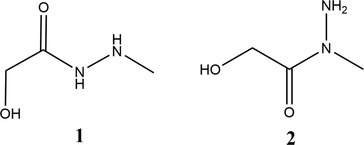Acta Crystallogr. E 2024, 80 (11), 1170-1174
DOI: 10.1107/S2056989024009526
The structures of the title compounds 2-hydroxy-N′-methylacetohydrazide, 1, and 2-hydroxy-N-methylacetohydrazide, 2, both C3H8N2O2, as regioisomers differ in the position of the methyl group relative to the N atoms in 2-hydroxy-acetohydrazide. In the structure of 1, the 2-hydroxy-acetohydrazide core [OH—C—C(=O)—NH—NH] is almost planar and the methyl group is rotated relative to this plane. As opposed to 1, in the structure of 2 all non-hydrogen atoms lie in the same plane. The hydroxyl and carbonyl groups in structures 1 and 2 are in trans and cis positions, respectively. The methyl amino group and carbonyl group are in the cis position relative to the C—N bond in structure 1, while the amino group and carbonyl group are in the trans position relative to the C—N bond in stucture 2. In the crystal, molecules of 1 are linked by N—H⋯O and O—H⋯N intermolecular hydrogen bonds, forming layers parallel to the ab crystallographic plane. A Hirshfeld surface analysis showed that the H⋯H contacts dominate the crystal packing with a contribution of 55.3%. The contribution of the H⋯O/O⋯H interaction is somewhat smaller, amounting to 30.8%. In the crystal, as a result of the intermolecular O—H⋯O hydrogen bonds, molecules of 2 form dimers, which are linked by N—H⋯O hydrogen bonds and a three-dimensional supramolecular network The major contributors to the Hirshfeld surface are H⋯H (58.5%) and H⋯O/O⋯H contacts (31.7%).

